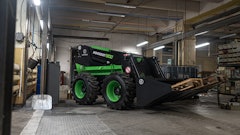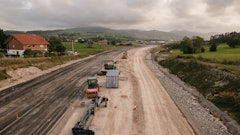
Information from this article was first published in Demolition Magazine and is being reused with permission from the National Demolition Association.
What do you do with a massive blimp hangar built during the Great Depression when you discover that its exterior shell might contain toxic substances? This was the issue that confronted a host of federal, state and local agencies in Northern California.
Built in 1929 by a German airship and structural engineer for the Goodyear Zeppelin Corp., Hangar One is located at what was originally known as U.S. Naval Air Station – Sunnyvale but has been known as Moffett Field during most of its life. The massive structure is over six football fields long, with an interior so large that fog would sometimes forms near its ceiling.
Hangar One covered over 8 acres measuring 1,133 feet in length and 198 feet in width. Its curved walls form an elongated catenary 198 feet high. The hangar’s doors weigh in at 200 short tons each and are moved by their own 150-hp motors. Narrow gauge tracks run the length of the hangar and extend out on the apron to facilitate moving airships to its mooring mast in preparation for flight.
The Navy’s initial plan was to demolish the massive structure. As part of the demolition planning, the Navy discovered that the hangar’s roof and walls contained asbestos, lead and PCBs. Thus began the debate whether to remove the structure completely or plan for its eventual rehabilitation and rebuilding. Initially, Hangar One was sealed with an asphalt coating designed to prevent any PCB leaching for three to five years. The Navy first offered to clean the hangar and coat its outsides with solar panels to recoup the cost of cleaning, but this plan proved too expensive, as did a plan to strip the toxic coating from the hanger’s exterior and leave its skeleton intact after spraying it with an encapsulant.
While identified as one of the 11 most threatened historical properties in the nation in 2008, the Navy awarded a multi-million dollar contract to AMEC to demolish the structure. The first step was the removal of Hangar One’s outer skin, subcontracted to NDA member NCM Group of Snoqualmie, Wash.
The Navy opted to use scaffolding for the project, weighing in at over 4.5 million tons, to reach the hangar’s curved walls. Seventeen tiers of wood and metal tower more than 140 feet high were constructed and moved around onsite as the work progressed. Near the top of the hangar, three tiers of plywood platforms were suspended by chains from the ceiling. NCM personnel used fall protection to make sure that they were safely tied off as the removal work progressed.
As one section of the exterior was removed, NCM would remove the scaffolding and reassemble it in the next location while working simultaneously on other sections. The firm used pressured water to clean the structural steel supports of the hanger, collecting the contaminated water in a man-made dike on the floor of the hangar and in a trench around its perimeter. This water was tested and treated before being disposed of in Sunnyvale’s sanitary sewer system.
NCM’s team removed panels of steel siding, some weighing between 30 and 70 pounds, and then lowered them carefully to the ground. Higher up within the structure, NCM found layers of California redwood which had been milled in Northern California in the 1920s during the heyday of the state’s redwood lumber industry.
NCM removed over 700,000 board feet, some 1.6 million tons, of this redwood siding. The company has been shaving off the lead-based paint and PCBs to decontaminate the lumber in order to safely recycle it. This old growth sequoia sempervirens is medium brown with red overtones in color and has been “certified” recycled by the Forest Stewardship Council.
Once the contaminated skin of Hangar One is completely removed the next step is still up in the air. While preservation of the structure along with the placement of a new exterior skin was included in the President’s proposed budget, the estimated $33 million dollar cost of this reconstruction may not be forthcoming.
Interestingly, Google executives recently offered to cover the cost of putting a new exterior on Hangar One in exchange for using part of the building to house its eight private jets.


























